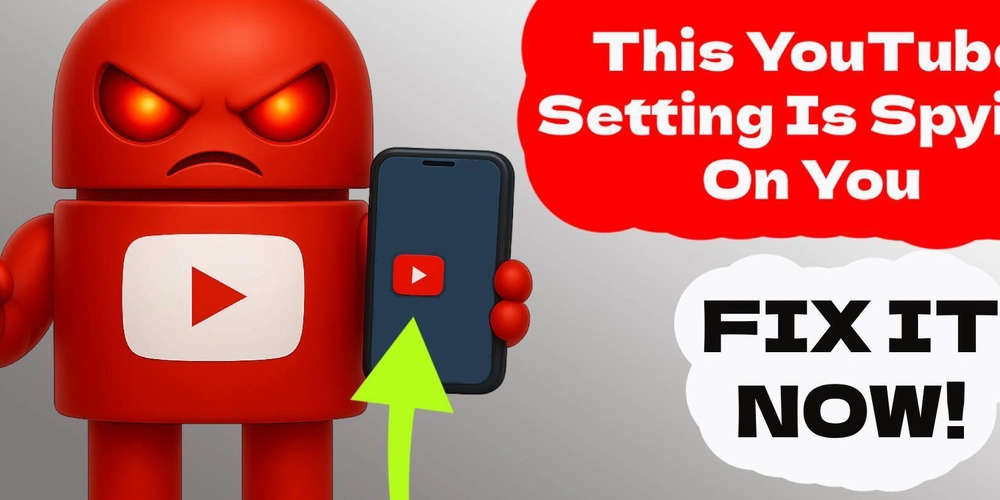When you open YouTube, you probably see it as a window into entertainment.
Billions of videos, tutorials, news updates, and creators at your fingertips.
But what most users don’t realize is that YouTube is not just a video platform. It’s also a data-collection machine tied directly into Google’s ecosystem. Every search, every video you click on, every second you spend watching is logged. These logs are combined with information from Gmail, Maps, Android, and your web browsing to create one of the most detailed behavioral profiles in human history.
If that sounds dramatic, consider this: Google does not simply measure what you watch. It measures when, where, and how you watch. If you watch late at night, on your phone, from a certain location, that becomes part of your profile. If you pause, rewind, or re-watch certain clips, that too is logged.
This article is not here to make you paranoid — it’s here to give you control.
YouTube’s privacy settings are hidden deep in your Google Account, but you can turn them off. In this extended guide, I’ll explain:
- Why YouTube data collection matters
- How Google integrates YouTube history into its wider tracking network
- Step-by-step instructions to disable tracking on Samsung, Xiaomi, and Google Pixel phones
- The consequences of leaving these settings enabled
- FAQs that cover common misunderstandings
Why YouTube Data Collection Is So Extensive
To understand why YouTube collects so much data, you have to see it in the bigger picture of the Google Network.
1. YouTube as an Identity Anchor
YouTube is tied to your Google Account. That means your watch history is connected to the same account that stores your Gmail, calendar events, Maps history, and even documents on Drive. If you’re logged in, your video activity is never anonymous.
2. Behavioral Profiling
Every click tells a story. Do you watch fitness channels? Finance tutorials? News outlets with a particular political leaning? YouTube builds a profile not just of your interests, but of your psychology. Advertisers buy into that profile, and in many cases, researchers and governments can request access too.
3. Cross-Platform Tracking
YouTube history is not confined to the app. It is used to personalize ads across websites, Android devices, and even smart TVs. This means that a single search on YouTube could change the ads you see across the entire internet.
4. Indefinite Storage
Unless you disable it, YouTube history is stored indefinitely. That’s decades of personal media consumption linked to your identity, with no built-in expiration date.
The Hidden Settings You Must Change
Inside your Google Account are three settings that power YouTube’s data collection. They are grouped under History Settings:
- Web & App Activity – tracks searches, clicks, and activity across Google apps (including YouTube).
- YouTube History – tracks every video you watch and search for.
- Location History – logs where you are when you use YouTube or other Google services.
By default, all three are switched on.
Turning these off prevents YouTube from saving future activity to your account.
Step-by-Step Guide: Samsung, Xiaomi, and Pixel
Here’s how to find and disable these settings on different devices.
Samsung (Android 14 / One UI 7)
- Open the YouTube app.
- Tap your profile icon (top-right).
- Choose Manage your Google Account.
- Swipe to the Data & Privacy tab.
- Under History Settings, you’ll see:
- Web & App Activity
- YouTube History
- Location History
- Tap each one → Turn Off → Confirm.
To go further:
- Open Settings → Apps → YouTube → Permissions.
- Remove unnecessary access like Microphone, Camera, and Location.
Xiaomi (MIUI / HyperOS)
- Open the YouTube app.
- Tap your profile picture → Manage your Google Account.
- In the account menu, switch to Data & Privacy.
- Under History Settings, disable all three options the same way: tap, scroll down, Turn Off, confirm.
Xiaomi adds its own layer of system services, so also:
- Open Settings → Apps → Manage apps → YouTube.
- Go to Permissions.
- Disable Microphone, Location, Camera unless you need them.
Google Pixel (Android 14 / Stock)
- Open Settings.
- Scroll to Google.
- Tap Manage your Google Account.
- Swipe to Data & Privacy.
- Under History Settings, toggle off Web & App Activity, YouTube History, and Location History.
- Confirm each change.
For app permissions:
- Open Settings → Apps → See all apps → YouTube.
- Tap Permissions → Deny or “Ask every time” for sensitive categories.
Step 2: Disable My Ad Center
Even if you stop history, YouTube data can still be fed into ad personalization. This is handled through Google’s My Ad Center.
Samsung
- Go to Google Account → Data & Privacy.
- Scroll down to My Ad Center.
- Toggle off Ad Personalization.
Xiaomi
- Open Settings → Google → Manage your Google Account.
- Under Data & Privacy, open My Ad Center.
- Disable Ad Personalization.
Pixel
- Open Settings → Google → Ads.
- Delete your Advertising ID or disable personalization directly in My Ad Center.
Step 3: Clear Past History
Disabling only stops future tracking. To wipe what’s already been collected:
- Go to Google Account → Data & Privacy.
- Under History Settings → YouTube History, tap Manage History.
- Use the options to:
- Delete last hour, last day, or a custom range
- Or choose Delete all time
- Or enable Auto-delete (every 3, 18, or 36 months)
This step ensures years of old searches and views aren’t sitting in Google’s servers waiting to be mined.
Why Bother Disabling All of This?
Some people argue: “I don’t mind — the recommendations are better when history is on.” And that’s true. Disabling history makes YouTube less personal, sometimes even clumsy.
But here’s what you gain in exchange:
- Privacy: Your interests, politics, and habits are not permanently logged.
- Security: Sensitive searches tied to your job or personal life aren’t available for future scrutiny.
- Battery life: Background data collection consumes power; shutting it off reduces drain.
- Peace of mind: Knowing that you’re not feeding the largest advertising network with every click.
Frequently Asked Questions
⭐ 1. Will YouTube stop working if I disable these settings?
No. The app still works normally: you can watch, subscribe, like, and comment. The difference is that YouTube won’t store your searches and history in your account.
⭐ 2. Can I delete past YouTube activity?
Yes. You can wipe it all. In the Google Account history menu, choose Delete all time. You can also set auto-delete for future activity.
⭐ 3. Will I still get ads?
Yes, but they’ll be generic rather than highly targeted. Some people find them less invasive, while others prefer hyper-relevant ads. It’s a trade-off.
⭐ 4. Are Samsung, Xiaomi, and Pixel really different?
The menus look different, but the underlying Google Account settings are the same. What changes is where you access them (inside the YouTube app, or inside Settings → Google).
⭐ 5. Can I re-enable history later?
Absolutely. You can turn history back on at any time. All the options are reversible.
⭐ 6. Does this protect me from all tracking?
No. Google still collects some anonymous metrics and logs. But disabling history and ads removes the deep profiling tied to your identity.
⭐ 7. What about other Google services?
Maps, Search, and Gmail also log massive amounts of data. If you’re serious about privacy, review their settings too.
⭐ 8. Does this improve battery life and performance?
Yes. Less background syncing means fewer silent requests and slightly better battery efficiency. Users often report longer standby times after disabling.
Closing Thoughts
YouTube is not “just” a video app. It’s part of Google’s global data-collection infrastructure — one of the most powerful behavioral databases in history.
For everyday users, this might mean ads that are a little too personal. For professionals, journalists, or activists, it could mean surveillance that impacts freedom of expression. For everyone, it represents an erosion of privacy that should not be accepted as the cost of entertainment.
The steps outlined here are not complicated. On Samsung, Xiaomi, and Google Pixel phones, it takes less than ten minutes to shut down history, clear old records, and strip away unnecessary permissions.
Will you lose some personalization? Yes. But you’ll gain control — and in today’s digital world, that control is priceless.
Your data is your identity. Don’t hand it away for free.



